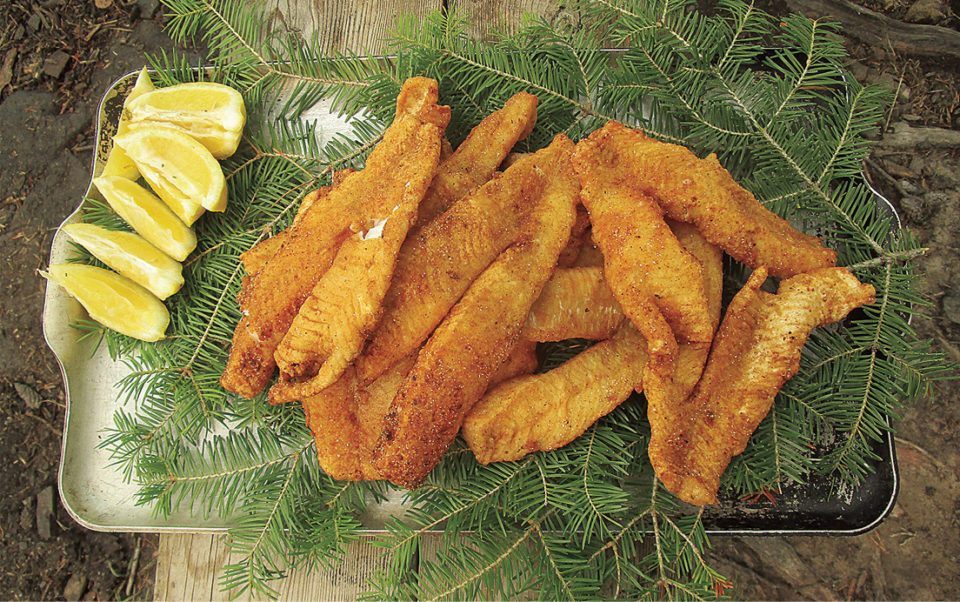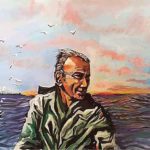I didn’t really learn to fish until I moved to the North Shore. This wasn’t due to a lack of time on the water.
I began fishing whenever possible around the age of four, starting with long sessions for sunfish off the dock at Aunt Dorie’s cabin. Soon I expanded my horizon to include brook trout. By age nine I couldn’t get enough of it, spending endless hours along the creeks and ponds in our neighborhood. The kids I fished with back then were better fishermen then the adults of our acquaintance. I still fish with one of them, my friend Alan Lutkevich.
Bicycles in our early teen years further broadened our horizons. Driver licenses were the game changer. We discovered steelhead, bass and the wonderful wild fishery that existed back then in the St. Louis River between Duluth and Superior. The river was terribly polluted, so you couldn’t eat the fish, but they were there for the catching.
At age 12, casting a fly I made, my first fly-caught fish came to hand, a tiny rainbow trout, soon followed by a brookie of equal stature. The passion for fly fishing and tying flies developed slowly and surely. Eventually I lost interest in fishing by other means. That said, a love of fresh walleye fillets and calm dawns of Lake Superior prevent me from becoming exclusively a fly fisher.
College and the years following introduced me to new anglers, waters and fishing methods. Living in the Twin Cities I was introduced to wily brown trout in the nearby creeks of western Wisconsin. I truly learned to fly cast on the wide reaches of the Mississippi River, where you never knew if your next catch might be a smallmouth bass, channel catfish or a common carp. All three were a joy to land with a fly rod.
Along the way from Aunt Dorie’s cabin to the Mississippi I became a decent angler. My fishing experience could be described as broad, varied and shallow. Perhaps that was the inevitable result of growing up in a place where endlessly varied fishing opportunities are available. I certainly don’t regret it.
Moving to the North Shore I made slow, sure steps to becoming a good angler. The key to doing so is simply achieving consistency. Fish the same waters frequently and you come to know the fish you seek and the place where they live intimately. Meet someone who likes to fish as much as you by compatible methods and you’ll become better still.
Arriving on the North Shore I first became adept at catching dinner-sized walleyes. My father was a walleye guy, so I was already on my way around the learning curve. Living in Grand Marais, I began fishing summer evenings with two brothers who were my coworkers at the Cook County News-Herald. Hal and Jon Kettunen were nearly obsessive in their pursuit of walleyes on a handful of nearby lakes. They were catch and keep anglers with such appetites I doubt either of them ever had more than a meal of walleyes stored in the freezer.
Their fishing techniques were simple and effective. Small jigs were baited with a minnow or two when the lake water was cold in the spring, shifting to leeches as the water warmed with the coming of summer. They were almost psychic at detecting the faintest strikes when the walleyes were “biting light.” Lessons learned from the brothers led Vikki and I to countless soft summer evenings on the water followed by platters heaped with golden fillets.
Dick Lenski was rooted in the soil of old school trout fishing, although his unique methods were his own. We fished the stocked trout lakes of the Gunflint country with his small canoe and an electric motor. He liked to troll with what he called a “spinner fly” that was often tipped with a tiny piece of nightcrawler. I was far enough down the fly-fishing path to forgo the worm, but I couldn’t match his success. People thought he was lying when he said how many trout he caught and released. He wasn’t. Fishing with him led me to pursue my own trout path with a fly rod and canoe.
Ken, publisher of the News-Herald and father of the Kettunen brothers, introduced me to the big hexagenia mayflies that rise from lake bottoms in midsummer to make their mating flight. In doing so, they create the best opportunity to fish with dry flies in lakes and ponds across the North. Kenny was among the very few North Shore anglers I’ve known who understood the mayflies and tied his own flies to imitate them. My dry flies are loosely based on his designs and have fooled brook trout, browns and walleyes for decades.
As important as learning from others is to becoming an angler, so, too, is teaching yourself. This was very true of my lifelong passion for steelhead, the big rainbow trout that spend their lives in Lake Superior, swimming up tributary streams in the spring to spawn. My friends and I had no mentors when we began fishing for them as young teens. We learned everything the hard way with lots of mistakes and false starts along the way. Rounding the bend of the learning curve was worth the effort, leading Lutkevich and I to uncountable adventures around Lake Superior and beyond.
Trolling for lake trout and salmon on Lake Superior near my Hovland home was something I largely taught myself, starting with an open 14-foot boat and eventually graduating to the 18-footer I use today. The early self-lessons stuck with me. Sometimes I wish my time was still spent in the 14-footer sliding along the shoreline where the next catch might be a 10-inch salmon or a 10-pound lake trout. These days I like to be on the water at dawn, when Superior is mirror-smooth and salmon chasing bait fish break the surface and shine like ingots of stainless steel in the rising sun. Catching a fish or two is sufficient, any more than that doesn’t necessarily make for a better day. Fish or not, I head in as the sun becomes bright. Other boats are just launching from the dock, but they’ve already missed the best of the day.
After a lifetime of doing it, there remains something new to learn or an old lesson to relearn every time I go fishing. Like most avid fly-fishers I often fish alone, with no company other than a patient Labrador retriever. Yet I relish the occasional times when I can get out with the few angling friends whose company I truly enjoy. My fishing sessions are usually just a couple of hours, because the best fishing rarely lasts longer than that. Good fishing is wonderfully satisfying, but poor fishing doesn’t disappoint. Being there, just fishing, is what truly matters to me.




